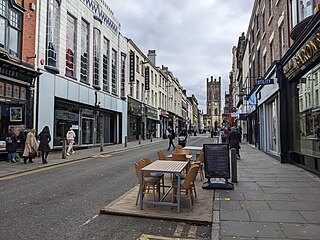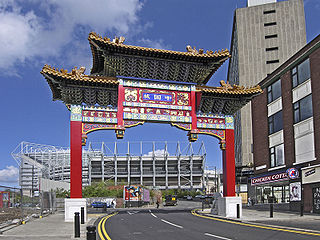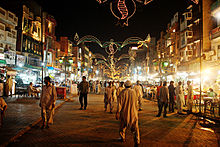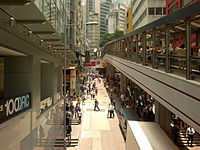
Chinatown is the catch-all name for an ethnic enclave of Chinese people located outside Greater China, most often in an urban setting. Areas known as "Chinatown" exist throughout the world, including Europe, Asia, Africa, Oceania, and the Americas.

İstiklal Avenue is a 1.4 kilometre (0.87 mi) pedestrian street in the historic Beyoğlu (Pera) district in Istanbul, Turkey. It is one of the most famous avenues in the city. It acquired its modern name after the declaration of the Republic on 29 October 1923, İstiklal (Independence) commemorating Turkey's triumph in its War of Independence.

This article discusses Chinatowns in the Americas, urban areas with a large population of people of Chinese descent. The regions include: Canada, the United States, and Latin America.
Chinatowns in Latin America developed with the rise of Chinese immigration in the 19th century to various countries in Latin America as contract laborers in agricultural and fishing industries. Most came from Guangdong Province. Since the 1970s, the new arrivals have typically hailed from Hong Kong, Macau, and Taiwan. Latin American Chinatowns may include the descendants of original migrants — often of mixed Chinese and Latino parentage — and more recent immigrants from East Asia. Most Asian Latin Americans are of Cantonese and Hakka origin. Estimates widely vary on the number of Chinese descendants in Latin America but it is at least 1.4 million and likely much greater than this.

Chinatowns in Asia are widespread with large concentrations of overseas Chinese in East Asia and Southeast Asia, and ethnic Chinese whose ancestors came from southern China — particularly the provinces of Guangdong, Fujian, and Hainan — and settled in countries such as Brunei, Cambodia, East Timor, Indonesia, India, Laos, Malaysia, Myanmar, the Philippines, Singapore, Sri Lanka, Thailand, Vietnam, Japan and Korea centuries ago — starting as early as the Tang dynasty, but mostly notably in the 17th–19th centuries, and well into the 20th century. Today the Chinese diaspora in Asia is primarily concentrated in Southeast Asia; however, the legacy of the once widespread overseas Chinese communities in Asia is evident in the many Chinatowns found across East, South and Southeast Asia.

Urban Chinatowns exist in several major European cities. There is a Chinatown in London, England, as well as major Chinatowns in Manchester, Birmingham, Newcastle and Liverpool. In Paris there are two Chinatowns: one where many Vietnamese – specifically ethnic Chinese refugees from Vietnam – have settled in the Quartier chinois in the 13th arrondissement of Paris which is Europe's largest Chinatown, and the other in Belleville in the northeast of Paris. Berlin, Germany has two Chinatowns, one in the East and one in the West. Antwerp, Belgium also has an upstart Chinese community.

Tanjong Pagar is a historic district located within the Central Business District of Singapore, straddling the Outram Planning Area and the Downtown Core under the Urban Redevelopment Authority's urban planning zones. The district has a rich history and is known for its cultural and architectural landmarks, making it a popular tourist destination.

Beyoğlu is a municipality and district of Istanbul Province, Turkey. Its area is 9 km2, and its population is 225,920 (2022). It is on the European side of Istanbul, Turkey, separated from the old city by the Golden Horn. It was known as the region of Pera surrounding the ancient coastal town Galata which faced Constantinople across the Horn. Beyoğlu continued to be named Pera during the Middle Ages and, in western languages, into the early 20th century.

Rua do Cunha is a narrow pedestrian street in Vila da Taipa, the town centre of Taipa, Macau. The street is named after Pedro Alexandrino da Cunha, a Portuguese navy captain who was the 81st Governor of Macau. He arrived in Macau in 1850 and he died 37 days later from cholera, being one of the first victims of the disease in Macau.

Night markets or night bazaars are street markets which operate at night and are generally dedicated to more leisurely strolling, shopping, and eating than more businesslike day markets. The culture of night markets originates from China and have spread globally with overseas Chinese populations. They are typically open-air markets popular in East Asia, Southeast Asia, and Chinatowns in several other regions of the world.

Indian Chinese cuisine, Chinese Indian cuisine, Sino-Indian cuisine, Chindian cuisine, Hakka Chinese or Desi-Chinese cuisine is a distinct style of Chinese cuisine adapted to Indian tastes, combining Chinese foods with Indian flavours and spices. Though Asian cuisines have mixed throughout history throughout Asia, the most popular origin story of the fusion food resides with Chinese labourers of Calcutta, who immigrated to British India looking for work. Opening restaurant businesses in the area, these early Chinese food sellers adapted their culinary styles to suit Indian tastes.

Chifa is a Chinese Peruvian culinary tradition based on Cantonese elements fused with traditional Peruvian ingredients and traditions. The term is also used to refer to restaurants that serve the chifa cuisine.

Barrio chino is a neighborhood in Lima, Peru that is centered on two blocks – 7 and 8 – of Jirón Ucayali in downtown. The neighborhood was founded in the mid-19th century by Chinese immigrants, but it was heavily damaged in the late 19th century by the War of the Pacific and further declined in the following decades. It experienced a revival starting in the 1970s and is now a thriving resource for Chinese-Peruvian culture.

A food street is a street lined with many food stalls, restaurants, and other food shops, and are typically pedestrianized. Food streets and food parks exist in several cities in Pakistan, and visiting them has become popular, with people using them as both formal and informal meeting areas.

The Rue de la République is a street located in the 1st and 2nd arrondissements of Lyon, France. It links the Place de la Comédie in the north to Place Le Viste in the south, just next to Place Bellecour, via the Place de la République.

Ropewalks is a district of Liverpool city centre bounded by Hanover Street to the north-west, Lydia Ann Street to the west, Roscoe Street to the east and Back Bold Street to north-east.

The Chinatown in Newcastle is a district of Newcastle upon Tyne, located in the west of the city, on the edge of the shopping and commercial centre, along Stowell Street. It is one of five Chinatowns in England, with the other four being in London, Birmingham, Manchester, and Liverpool.





























